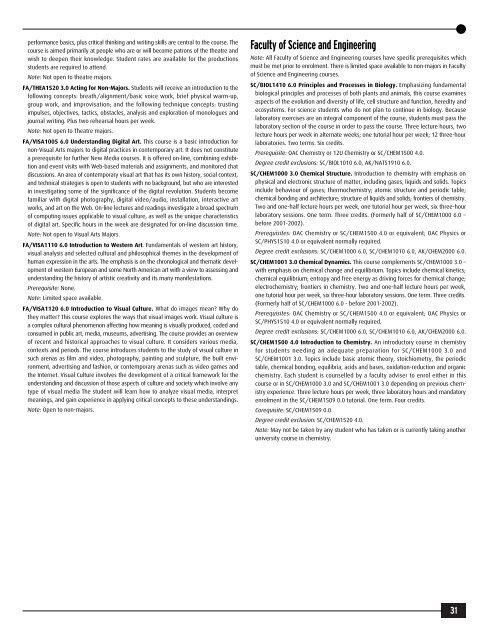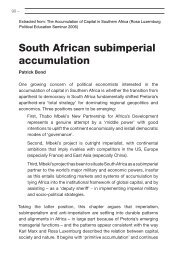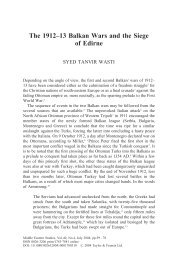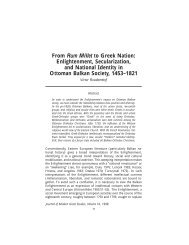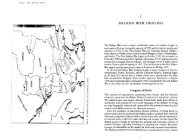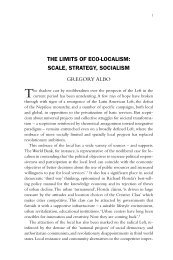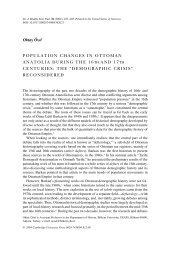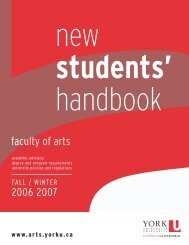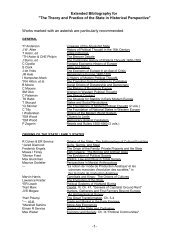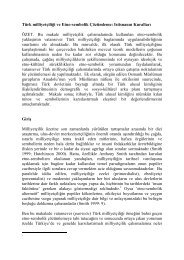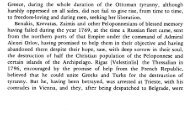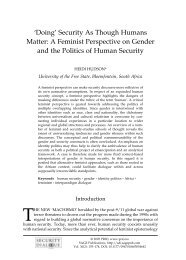FYCSG 05/06 REV2 - Faculty of Arts - York University
FYCSG 05/06 REV2 - Faculty of Arts - York University
FYCSG 05/06 REV2 - Faculty of Arts - York University
You also want an ePaper? Increase the reach of your titles
YUMPU automatically turns print PDFs into web optimized ePapers that Google loves.
performance basics, plus critical thinking and writing skills are central to the course. The<br />
course is aimed primarily at people who are or will become patrons <strong>of</strong> the theatre and<br />
wish to deepen their knowledge. Student rates are available for the productions<br />
students are required to attend.<br />
Note: Not open to theatre majors.<br />
FA/THEA1520 3.0 Acting for Non-Majors. Students will receive an introduction to the<br />
following concepts: breath/alignment/basic voice work, brief physical warm-up,<br />
group work, and improvisation; and the following technique concepts: trusting<br />
impulses, objectives, tactics, obstacles, analysis and exploration <strong>of</strong> monologues and<br />
journal writing. Plus two rehearsal hours per week.<br />
Note: Not open to Theatre majors.<br />
FA/VISA10<strong>05</strong> 6.0 Understanding Digital Art. This course is a basic introduction for<br />
non-Visual <strong>Arts</strong> majors to digital practices in contemporary art. It does not constitute<br />
a prerequisite for further New Media courses. It is <strong>of</strong>fered on-line, combining exhibition<br />
and event visits with Web-based materials and assignments, and monitored chat<br />
discussions. An area <strong>of</strong> contemporary visual art that has its own history, social context,<br />
and technical strategies is open to students with no background, but who are interested<br />
in investigating some <strong>of</strong> the significance <strong>of</strong> the digital revolution. Students become<br />
familiar with digital photography, digital video/audio, installation, interactive art<br />
works, and art on the Web. On-line lectures and readings investigate a broad spectrum<br />
<strong>of</strong> computing issues applicable to visual culture, as well as the unique characteristics<br />
<strong>of</strong> digital art. Specific hours in the week are designated for on-line discussion time.<br />
Note: Not open to Visual <strong>Arts</strong> Majors.<br />
FA/VISA1110 6.0 Introduction to Western Art. Fundamentals <strong>of</strong> western art history,<br />
visual analysis and selected cultural and philosophical themes in the development <strong>of</strong><br />
human expression in the arts. The emphasis is on the chronological and thematic development<br />
<strong>of</strong> western European and some North American art with a view to assessing and<br />
understanding the history <strong>of</strong> artistic creativity and its many manifestations.<br />
Prerequisite: None.<br />
Note: Limited space available.<br />
FA/VISA1120 6.0 Introduction to Visual Culture. What do images mean? Why do<br />
they matter? This course explores the ways that visual images work. Visual culture is<br />
a complex cultural phenomenon affecting how meaning is visually produced, coded and<br />
consumed in public art, media, museums, advertising. The course provides an overview<br />
<strong>of</strong> recent and historical approaches to visual culture. It considers various media,<br />
contexts and periods. The course introduces students to the study <strong>of</strong> visual culture in<br />
such arenas as film and video, photography, painting and sculpture, the built environment,<br />
advertising and fashion, or contemporary arenas such as video games and<br />
the Internet. Visual Culture involves the development <strong>of</strong> a critical framework for the<br />
understanding and discussion <strong>of</strong> those aspects <strong>of</strong> culture and society which involve any<br />
type <strong>of</strong> visual media The student will learn how to analyze visual media, interpret<br />
meanings, and gain experience in applying critical concepts to these understandings.<br />
Note: Open to non-majors.<br />
<strong>Faculty</strong> <strong>of</strong> Science and Engineering<br />
Note: All <strong>Faculty</strong> <strong>of</strong> Science and Engineering courses have specific prerequisites which<br />
must be met prior to enrolment. There is limited space available to non-majors in <strong>Faculty</strong><br />
<strong>of</strong> Science and Engineering courses.<br />
SC/BIOL1410 6.0 Principles and Processes in Biology. Emphasizing fundamental<br />
biological principles and processes <strong>of</strong> both plants and animals, this course examines<br />
aspects <strong>of</strong> the evolution and diversity <strong>of</strong> life, cell structure and function, heredity and<br />
ecosystems. For science students who do not plan to continue in biology. Because<br />
laboratory exercises are an integral component <strong>of</strong> the course, students must pass the<br />
laboratory section <strong>of</strong> the course in order to pass the course. Three lecture hours, two<br />
lecture hours per week in alternate weeks; one tutorial hour per week; 12 three-hour<br />
laboratories. Two terms. Six credits.<br />
Prerequisite: OAC Chemistry or 12U Chemistry or SC/CHEM1500 4.0.<br />
Degree credit exclusions: SC/BIOL1010 6.0, AK/NATS1910 6.0.<br />
SC/CHEM1000 3.0 Chemical Structure. Introduction to chemistry with emphasis on<br />
physical and electronic structure <strong>of</strong> matter, including gases, liquids and solids. Topics<br />
include behaviour <strong>of</strong> gases; thermochemistry; atomic structure and periodic table;<br />
chemical bonding and architecture; structure <strong>of</strong> liquids and solids; frontiers <strong>of</strong> chemistry.<br />
Two and one-half lecture hours per week, one tutorial hour per week, six three-hour<br />
laboratory sessions. One term. Three credits. (Formerly half <strong>of</strong> SC/CHEM1000 6.0 –<br />
before 2001-2002).<br />
Prerequisites: OAC Chemistry or SC/CHEM1500 4.0 or equivalent; OAC Physics or<br />
SC/PHYS1510 4.0 or equivalent normally required.<br />
Degree credit exclusions: SC/CHEM1000 6.0, SC/CHEM1010 6.0, AK/CHEM2000 6.0.<br />
SC/CHEM1001 3.0 Chemical Dynamics. This course complements SC/CHEM1000 3.0 –<br />
with emphasis on chemical change and equilibrium. Topics include chemical kinetics;<br />
chemical equilibrium; entropy and free energy as driving forces for chemical change;<br />
electrochemistry; frontiers in chemistry. Two and one-half lecture hours per week,<br />
one tutorial hour per week, six three-hour laboratory sessions. One term. Three credits.<br />
(Formerly half <strong>of</strong> SC/CHEM1000 6.0 - before 2001-2002).<br />
Prerequisites: OAC Chemistry or SC/CHEM1500 4.0 or equivalent; OAC Physics or<br />
SC/PHYS1510 4.0 or equivalent normally required.<br />
Degree credit exclusions: SC/CHEM1000 6.0, SC/CHEM1010 6.0, AK/CHEM2000 6.0.<br />
SC/CHEM1500 4.0 Introduction to Chemistry. An introductory course in chemistry<br />
for students needing an adequate preparation for SC/CHEM1000 3.0 and<br />
SC/CHEM1001 3.0. Topics include basic atomic theory, stoichiometry, the periodic<br />
table, chemical bonding, equilibria, acids and bases, oxidation-reduction and organic<br />
chemistry. Each student is counselled by a faculty adviser to enrol either in this<br />
course or in SC/CHEM1000 3.0 and SC/CHEM1001 3.0 depending on previous chemistry<br />
experience. Three lecture hours per week, three laboratory hours and mandatory<br />
enrolment in the SC/CHEM1509 0.0 tutorial. One term. Four credits.<br />
Corequisite: SC/CHEM1509 0.0.<br />
Degree credit exclusion: SC/CHEM1520 4.0.<br />
Note: May not be taken by any student who has taken or is currently taking another<br />
university course in chemistry.<br />
31


